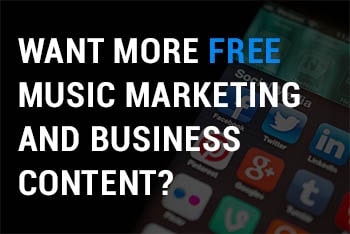
Last Updated: 9/5/23
You built up a mailing list of fans that love your music and want to hear more from you. Unfortunately, you’ve noticed that the open rates from your emails are not as high as you would expect. A 25% email open rate seems pretty low, but is it a cause for concern?
What is an open rate?
Simply put, an open rate is just how many people opened the email divided by the total number of emails sent (excluding any bounced emails). So, if you emailed 100 fans and only 25 opened the email, you have an open rate of 25%. Using the same scenario, if 5 of those emails bounced (meaning the email was unable to be delivered), you would have an open rate of 26%. 25 / (100 – 5) = 26%
With all the math out of the way, the goal is to obviously maintain a high open-rate. For the sake of context, is your open rate really that bad to begin with?
What are music industry standards for email open rate?
To help level your expectations, here are the average open rates from two popular email marketing services. These stats are current from this year.
Constant Contact (Art, Culture, Entertainment): 15.65%
As you can see, the average open rate for the music industry is about 20%. That’s not too bad, but there’s always room for improvement. As independent artists, it’s important to maximize your efficiency to get the most out of the time and effort you invest in marketing your music. Here are 5 things you can try to increase your email open rates and actually get your message to the fans.
1. Write compelling subject lines
The most important part of your email is the subject line. If you can’t get your fan’s attention to click on your email, everything else in the body goes to waste.
64% of email recipients open email based on the subject line.
The most fundamental element for a compelling subject line is it needs to clearly promise something of value to your fans that can be delivered in the body of the email.. How you go about communicating that value can be done relatively simply and straightforward for musicians. Generally, the 3 big topics fans like to hear about are new music, new tours/shows or new merch so subject lines will likely be something like:
- My new single “…” just dropped, now streaming everywhere!
- Listen now! My new album “…” out on all platforms!
- NEW Tour Just Announced!
- New single and music video out now! Watch it here…
- New merch just added to the shop, limited quantities available!
You can take the next step and think about your brand voice and incorporate it into the language. Whenever possible, try to create urgency or even sparking curiosity. Coming up with a good subject line can take some time and practice but the results will incentivize you to keep trying new approaches.
- Know your fans and write to appeal to what they are interested in.
- Make sure the subject line is no longer than 50 characters or it may get cut off.
- Include 1 or 2 emojis. I like to use 1 in the very beginning that relates to the overall purpose of the email.
- Explain clearly and concisely what the purpose and value of the email is.
- Use a conversational tone and avoid sounding too promotional.
- Include a verb to influence action. (Example: Hear a sneak peak of the new album!)
- Be personal by using their first name. You can do this with Merge Tags.
- Be honest. Don’t try to make up something just to get people to click.
- Write it less formally so it comes off as personal email (Example: hey, do you still want to hear the new album?)
- Ask a question (example: Do you want to hear new music?)
2. Make sure your email does not get sent to spam
As you know, email spam has been an ongoing issue for over a decade now. There have been laws and protocols, such as CAN-SPAM and DMARC, put in place to help regulate this annoying practice. For the most part, our email service providers have done a great job of filtering out most of the unwanted junk we randomly receive. It’s not a perfect system, and sometimes emails that your fans are expecting can end in their spam folder.
A lot of email services out there have spam filters so you want to make sure your email does not get marked as potential spam.
- Verify your domain – Marketing emails that show it was sent from a free email service provider like Gmail and Yahoo Mail are not as trustworthy as ones sent from a domain name (@yourbandname.com). For email marketing services like Mailchimp, you have the option of verifying your domain to show you own it. This way, you can send emails that show it came from david@yourbandname.com rather than sending emails to your fans that show it came from a free email service provider domain. Learn more about verifying your domain.
- Use a legit mailing list – Make sure your email list was not bought or collected without permission. Aside from getting you in trouble with your email marketing service, it is also against the law. You never want to send emails to people who have not given their permission or properly opted in to receive marketing emails from you.
- Don’t use spammy language in the subject line – Certain words will trigger your fan’s email filters so be careful with what you write. Examples of trigger words that might get an email labeled as spam include: sales, free, click here, open, visit our website, this isn’t spam, please read, limited time, get it now, don’t delete.
- The easiest one of all is to encourage your fans to add your email address to their contacts or directory.
3. Send email as an actual person
It’s common for artists to send out an email as the band or stage name. Sometimes you may see more generic names like Booking, Contact or Info.
It has been shown in the non-music industry world that email recipients are more likely to open an email from a person rather than a company, title or organization. This makes sense. We want to connect with humans and not just something or an entity. So for music artists, it may be worth testing to see if your open rates improve when the “sent from” name is changed to something more personal. If your stage name is your real name and you send emails out as yourself, there shouldn’t be a problem.
Using your real name, as opposed to a stage name, can work against you if people are not familiar with your real name. To fix this issue, use your real name and put your stage name parenthesis. Or if you’re in a group, choose someone’s name in the band then put in parenthesis the band name.
4. Take advantage of the preview text
As you may be aware (especially if you use the email app on iPhone, Gmail or Yahoo Mail), your inbox will show sample text from the email body following the subject line. Since you don’t want to use too many words in the subject line, this is a good opportunity to draw more attention to your email and convince fans to open the email. Most email marketing services allow you to edit the first sentence of text that displays in the preview text portion of the email.
If your email marketing service does not have this function, remember that the preview text is pulled from the body of your email. Some emails, as a default, will say on the top, “If you do not wish to receive messages from … please go here.” That’s a waste of space. As indie artists, it’s all about making the most of what you’ve got, so optimization is important.
5. Don’t email your fans too much (follow the golden rule: quality not quantity)
Last but not least, don’t send too many emails. If you send too often, you may get ignored and your open rates will decline. The worst-case scenario is your fans will unsubscribe.
Remember that your fans’ email addresses are sacred online property. It’s your direct online connection to them, like a physical address to their home. You have to be selective of what content is email worthy or should only be posted on social media.
As a fan, I would say a reasonable amount would be no more than 2 emails a month. On average, I would say 1 or 2 every couple of months. It all depends on what value and content you are providing, so use your own discretion. If you have a big announcement, and you’ve already sent a couple of emails that month, don’t hold back – share your big news!
Conclusion
Now that you are more aware of the different factors that can influence open rates, you can test them out. When doing any testing, remember to test one element at a time. Don’t make the mistake of trying to test everything at once, because then you won’t know what was responsible for the results. Email marketing services like Mailchimp allow you to create two versions of the subject line and email that get sent to your mailing list (half get version A, the other gets version B). Based on the variations you made, you can see which performed better. This is known as A/B testing, and I encourage you to give it a try.
Getting people to open an email is only half the battle. Once you get their attention, you want them to take action. In a future blog, I will explore how to get people to click on links in your email.








